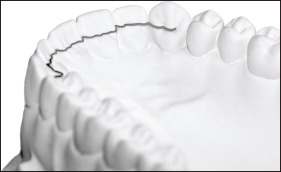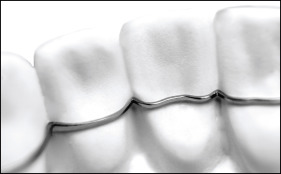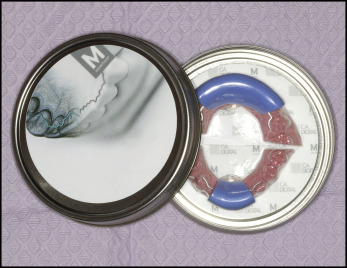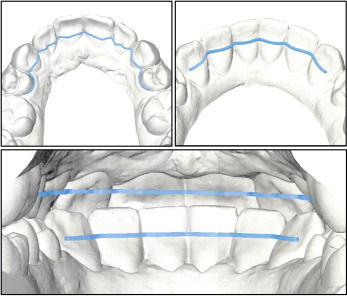Approximately 1/2 of maxillary and 1/5 of mandibular multi-stranded lingual retainers fail during retention in some form, either bond failure or wire breakage. Memotain is a new CAD/CAM fabricated lingual retainer wire made of custom-cut nickel-titanium, as an alternative to multi-stranded lingual retainers. It offers numerous perceived advantages to the traditional multi-stranded stainless steel wire, including precision fit, avoidance of interferences, corrosion resistance and even the potential for minor tooth movement as an active lingual retainer.
Highlights
- •
A new CAD/CAM fabricated nickel-titanium retainer is proposed.
- •
The retainer is custom cut from nickel-titanium sheets and electropolished.
- •
It enables more precise bonding without occlusal interference or microbial colonization.
Lingual retainer wire technology has changed little over the last 40 years. The 2 most widely used retainers remain the thick (0.025 to 0.032 in) round stainless steel wire bonded only to the canines and the thin (0.0195 or 0.0215 in) multistranded wire bonded to the incisors and canines. Multistranded wires have become more common for their improved esthetics and control of the mandibular incisors, although these retainers have significant drawbacks.
The primary problem of multistranded lingual wires is their high failure rate. Clinical studies indicate that 23% to 58% of maxillary retainers and 5% to 37% of mandibular retainers fail during retention in some form, either bond failure or wire breakage. Other disadvantages include difficulty flossing, plaque accumulation, stretching of the wire causing malalignment or spacing, unraveling, introduction of unwanted torque, irritation to the tongue, and occlusal interference (for the maxillary retainer).
As a result of the need for frequent repair, many orthodontists are reluctant to provide bonded lingual retainers to their patients. Those who do frequently must remove the wire for 1 of the above reasons at some point during retention. Today, lingual retainers, commonly referred to by patients as “permanent” retainers, are often just a temporary solution.
The purpose of the article is to introduce Memotain—a new CAD/CAM fabricated lingual retainer wire made of custom-cut nickel-titanium—as an alternative to multistranded lingual retainers. Memotain’s material properties, manufacturing process, bonding protocol, and potential advantages will be reviewed.
Memotain is a CAD/CAM fabricated lingual retainer made of 0.014 × 0.014-in rectangular nickel-titanium. The wire is highly flexible and custom cut to precisely adapt to the patient’s lingual tooth anatomy ( Fig 1 ). It was invented in 2012 by an orthodontist, Pascal Schumacher. The name Memotain is a portmanteau from the combination of “memory” and “retainer” because of the uniqueness of using nickel-titanium for the lingual wire.

Although Memotain uses CAD/CAM, the wire material and manufacturing process differ from the SureSmile wire (OraMetrix, Richardson, Tex). SureSmile uses a copper-nickel-titanium wire bent by a robot hand; a split second of intense heat is applied during the bend to create plastic deformation. Memotain is not bent at all. Rather, the wire is cut from a nickel-titanium sheet—called a “blank”—similar to a scissors cutting a piece of paper. The result is a custom-cut wire with smooth curvatures. This type of fabrication is ideal, since bending sites increase the risk of wire fracture.
After the wire is cut from the nickel-titanium sheet, it is electropolished. Electropolishing uses electrolysis to clean a metal alloy. In this process, the wire is submerged in an ion-charged bath. Running a current through the bath gradually removes material from the wire’s microscopic surface. As a result of electropolishing, the wire becomes brightened, cleaned, smoothed, polished, corrosion resistant, and less susceptible to microbial colonization. This process also causes the corners of the rectangular wire to be slightly rounded ( Fig 2 ).

To place an order, the orthodontist can submit a polyvinylsiloxane impression or an intraoral scan in STL format. Memotain is digitally positioned to prevent occlusal interferences; therefore, if an impression is taken for a maxillary retainer, the orthodontist should also submit a mandibular impression with a bite registration. Typically, the orthodontist will submit the scan with the braces still on and bond the retainer before debanding; however, this is not possible with lingual braces. The custom lingual wire and a silicone putty transfer jig are mailed to the orthodontist in approximately 2 weeks ( Fig 3 ).

The digitally planned position can be transferred clinically with less than 0.5 mm of error. Bonding the lingual retainer follows a traditional protocol of prophylaxis, etchant, primer, and placement of luting agent. A broad but thin application of luting agent is recommended to take advantage of the retainer’s custom fit. We advocate a nano-hybrid flowable resin, such as Tetric EvoFlow (Ivoclar Vivadent, Amherst, NY).
Memotain is manufactured by CA-Digital in Mettmann, Germany, and will soon be distributed by AOA Laboratory (Sturtevant, Wis) in the United States. Currently, the price for a single-arch Memotain retainer from canine to canine is €145, or approximately $162 including shipping and handling to the United States; however, domestic distribution will cost significantly less. Memotain comes with a 24-month warranty.
Memotain offers numerous perceived advantages to traditional multistranded lingual wires, including no need for wire measuring or bending, individually optimized placement, greater accuracy of fit, tighter interproximal adaptation, less tongue irritation, better durability, and resistance to microbial colonization. However, clinical trials are necessary to determine whether these advantages are substantiated with scientific data.
This retainer may be most the advantageous in the maxillary arch, where multistranded wires frequently fail. Maxillary anterior teeth commonly have large marginal ridges or atypical shapes (ie, peg-shaped lateral incisors, talon cusps, invaginations) that make close adaptation with hand-bent wires challenging. Memotain’s tight interproximal wrap is beneficial in common break-point areas, such as the embrasure between the lateral incisor and the canine, or the step between the canine and the premolar. Furthermore, it is digitally positioned to prevent contact with the mandibular teeth ( Fig 4 ).





